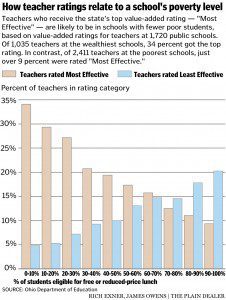I have just finished my third year of teaching, and am still awaiting final results from my students’ high-stakes Oklahoma Core Curriculum Tests. These are the tests that will determine the Value-Added Measure score on my future teacher evaluations.
I am concerned that VAM does not actually measure my value as a teacher. Let me tell you why.
The very first year I taught — as an alternately certified teacher with a Bachelor’s degree in journalism, six years of experience as a newspaper reporter and almost 10 years experience managing a web design and hosting company — 92 percent of my students passed their English II End-of-Instruction (EOI) exam. This is up from the 88 percent of students who passed the previous year, under the teacher who had retired.
That’s pretty good for a brand new teacher, right? That means I must have been pretty good, right?
Wrong!
In retrospect, I was a terrible teacher that year. My lessons weren’t aligned to standards, didn’t require enough critical thinking skills, and were not engaging. My poetry class nearly revolted. My principal observed me (formally) once and gave me a 3 (effective) on my Tulsa TLE evaluation.
The Marzano evaluation system was introduced during my second year of teaching. My school provided professional development opportunities to help me learn what was expected in the four domains of the Marzano evaluation system. A different principal gave me a 3 (developing) on my first Marzano evaluation of the year.
In my second evaluation, he added a few 4s (applying) on different sections of my score.
Through the course of my second and third year, I had the opportunity to work with a special education co-teacher with more than 20 years teaching experience. Right off the bat, she helped me improve my classroom management, design engaging lessons, recognize when and respond to students who need help. She helped me revolutionize my teaching practice. I also spent time pouring over the Marzano evaluation documentation and adjusting my teaching accordingly.
This past school year, I received one 5 (innovating) amid a sea of 4s (applying) on my evaluation from two more principals, for a final score of Applying.
Any way you look at it, it appears that I have improved my teaching practice, and have become a much better teacher, right?
By that logic, one would assume that a greater percentage of my students passed their exams during my second and third year and VAM should not hurt me, right?
Wrong!
My first school, located in a rural area with low poverty, did not invite me back for a second year. Instead, I went to teach at a high poverty middle school where 20 percent of the students are on an Individualized Education Program (IEP) requiring modified assessment, and at least half of the students read below grade level.
Only about 50 percent of my students passed their Oklahoma Core Curriculum Tests in my second and third years of teaching, in spite of the significant improvement in my pedagogy and improvements in their STAR reading scores, which they took at multiple points during the year (All my classes improved significantly, according to STAR).
By high-stakes testing scores, I was a wonderful teacher my first year (even though my temporary contract didn’t get renewed) and a terrible teacher the last two years!
My experience aligns with the first large-scale study of VAM systems:
In the first large-scale analysis of new systems that evaluate teachers based partly on student test scores, two researchers found little or no correlation between quality teaching and the appraisals teachers received.
The study, published Tuesday in Educational Evaluation and Policy Analysis, a peer-reviewed journal of the American Educational Research Association, is the latest in a growing body of research that has cast doubt on whether it is possible for states to use empirical data in identifying good and bad teachers, according to Good teaching, poor test scores: Doubt cast on grading teachers by student performance.
I’m not alone.
Two years ago, a Florida teacher with 25 years experience was voted Teacher of the Year — and received an unsatisfactory on her evaluation because of VAM.
This year, Houston teachers are suing their district over allegations that VAM is inaccurate and unfair.
The graphic below shows the correlation between the number of students eligible for free and reduced lunches and the percentage of teachers in the school achieving “most effective” ratings:
You can read about Oklahoma’s plans for VAM in this PowerPoint presentation:
We must fight this before we start punishing those teachers who have dedicated their lives to teaching our toughest, neediest, most heart-breaking students.



